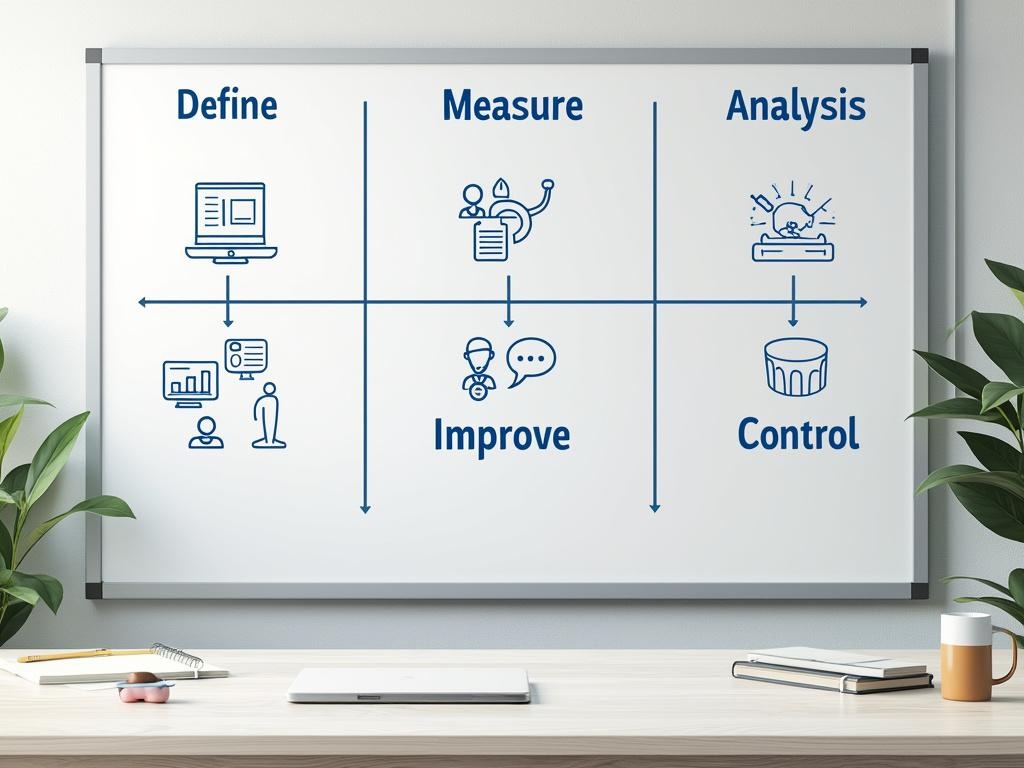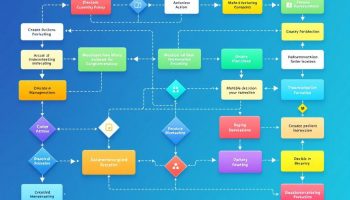
Understanding the DMAIC Plan
A DMAIC plan offers a structured five-step approach (Define, Measure, Analyze, Improve, Control) that systematically solves problems and implements lasting process improvements in organizations. This data-driven methodology provides a framework that guides teams through identifying issues, measuring current performance, analyzing root causes, implementing solutions, and establishing control mechanisms to sustain improvements.
How DMAIC Plans Drive Organizational Excellence
DMAIC plans are crucial for businesses aiming to eliminate inefficiencies, cut costs, and boost customer satisfaction. By applying this structured methodology, you can transform subjective opinions into objective, data-driven decisions that directly impact your bottom-line results. The systematic nature of a DMAIC plan prevents jumping to solutions before fully understanding problems, ensuring your resources target root causes rather than symptoms. This methodical approach helps you achieve measurable process improvements while creating standardized procedures that maintain gains long-term.
The DMAIC framework gives you a reliable roadmap for continuous improvement projects. You’ll find it particularly valuable when tackling complex operational challenges that require cross-functional collaboration. The plan’s emphasis on data collection and analysis removes guesswork from decision-making processes.
Each phase of your DMAIC plan builds on previous steps, creating a logical progression from problem identification to sustainable solution implementation. You’ll notice how this approach minimizes the risk of implementing changes that don’t address actual business needs.
Implementing a DMAIC Plan: Your Pathway to Process Improvement
A well-executed DMAIC plan transforms your business operations through systematic problem-solving. This proven five-step approach (Define, Measure, Analyze, Improve, Control) gives you a clear framework to identify issues, create solutions, and maintain positive changes. Your team can tackle operational challenges with confidence by following this data-driven methodology that eliminates guesswork.
The DMAIC plan starts by defining your problem’s scope and setting measurable goals. You’ll then collect performance data to establish a baseline before using statistical analysis to uncover root causes. After implementing targeted improvements based on your findings, you’ll set up control systems to preserve your gains. This sequential process ensures each step builds on solid evidence rather than assumptions.
Companies that correctly apply DMAIC plans see tangible benefits: reduced waste, higher quality products, decreased costs, and increased customer satisfaction. The DMAIC methodology provides structure that prevents the common mistake of rushing to solutions before thoroughly understanding problems. Your investment in this systematic approach delivers quantifiable results that impact your bottom line.
1. Define the Problem and Project Scope
Starting your DMAIC plan requires a clear definition of the problem you aim to solve. Developing a comprehensive project scope helps you establish boundaries for your process improvement initiative. Begin by identifying the specific business problem or opportunity that needs addressing. Your DMAIC plan should include a project charter that outlines key objectives, stakeholders, and constraints.
Map your current process using a SIPOC diagram (Suppliers, Inputs, Process, Outputs, Customers) to gain a holistic view of workflow interactions. This visual representation helps team members understand the existing process before implementing changes. Define customer requirements through Voice of Customer (VOC) data collection to ensure your DMAIC project addresses genuine needs.
Set clear project goals with measurable targets and establish a realistic timeline with defined milestones. Finally, establish team roles and responsibilities to ensure accountability throughout the improvement process. When everyone understands their part in the DMAIC plan, project collaboration becomes more effective and focused.
2. Measure Current Performance
Collecting accurate baseline data forms the foundation of your DMAIC plan implementation. You need reliable measurements to determine how your current process performs before making improvements. Start by gathering comprehensive process data using appropriate sampling techniques that reflect normal operating conditions.
When validating your measurement systems, conduct Gage R&R (Repeatability and Reproducibility) studies to ensure your data collection tools provide consistent results across different operators and measurement instances. This critical step ensures the accuracy of your DMAIC plan and prevents decisions based on unreliable data.
Next, calculate your process capability indices like Cp and Cpk to quantify how well your process meets specifications. These metrics help you establish clear process improvement targets and provide a baseline for measuring future enhancements.
Document your data collection methodology thoroughly, including sampling plans, measurement techniques, and data sources. Create meaningful process performance metrics that align with your project goals and customer requirements. Finally, establish effective data visualization methods such as control charts, histograms, and box plots to communicate performance trends clearly to stakeholders and team members throughout your DMAIC plan implementation.
Expert Insight: To effectively measure current performance, gather comprehensive baseline data through appropriate sampling techniques and validate measurement systems with Gage R&R studies. Calculate process capability indices like Cp and Cpk to set clear improvement targets, while documenting your methodology and using data visualization tools to communicate trends effectively.
3. Analyze Root Causes
The third phase of your DMAIC plan focuses on identifying what’s truly causing performance issues. When analyzing root causes, begin by mapping potential cause-and-effect relationships that impact your process outcomes. Your DMAIC plan should include thorough statistical analysis to validate which factors significantly influence performance metrics.
Root cause analysis tools provide structure to your investigation. The 5 Whys technique helps you dig deeper by repeatedly asking why a problem occurs, while Fishbone diagrams (also called Ishikawa diagrams) organize potential causes into categories like People, Methods, Materials, and Equipment. These visual frameworks make your root cause analysis more comprehensive and systematic.
Data validation is crucial in this phase. Test each hypothesis with relevant data to confirm or eliminate potential causes. This evidence-based approach prevents you from implementing solutions that address symptoms rather than underlying problems. After validation, prioritize improvement opportunities based on impact potential and feasibility within your DMAIC plan framework.
Document all findings meticulously, including rejected hypotheses, as they provide valuable context for project stakeholders and future improvement initiatives. Well-documented analysis creates a solid foundation for the Improve phase that follows.
Expert Insight: In the Analyze phase of DMAIC, use structured root cause analysis tools like the 5 Whys and Fishbone diagrams to uncover underlying issues. Validate hypotheses with relevant data to ensure solutions target root problems. Meticulously document findings for informed decision-making and future improvement initiatives.
4. Improve Process Performance
The improvement phase is where your DMAIC plan transforms from analysis into action. Developing potential solutions requires creativity and collaboration from your team to address the root causes identified in the analysis phase. Your improvement options should directly target the specific issues impacting your process performance.
When evaluating alternatives, use weighted criteria to assess each option based on implementation cost, timeline, potential impact, and resource requirements. This structured approach helps you select the most promising solutions for pilot testing. Before full implementation, conduct pilot tests to validate that your improvements work as expected in a controlled environment.
Measuring results against baseline data is crucial for quantifying the impact of your DMAIC plan. Compare key metrics before and after implementation to demonstrate ROI. Track both primary and secondary metrics to capture the full scope of improvements.
After successful pilot testing, implement the solutions across the entire process. Create implementation approaches that include transition plans, training materials, and communication strategies. Document all process changes thoroughly, including updated procedures, workflow diagrams, and new standard operating procedures, to ensure consistency in the new process.
Expert Insight: To enhance process performance, leverage creativity and team collaboration during the improvement phase. Employ weighted criteria to evaluate solutions, ensuring effective pilot testing before full implementation. Finally, document all changes meticulously to maintain consistency and facilitate smooth transitions across the new process.
5. Control and Sustain Results in Your DMAIC Plan
The final phase of your DMAIC plan focuses on maintaining the gains you’ve achieved. Implementing effective control mechanisms ensures your process improvements become permanent fixtures rather than temporary fixes. Begin by standardizing new procedures through detailed documentation that clearly outlines each step of the improved process. This standardization is crucial to embedding the DMAIC plan improvements into daily operations.
Create comprehensive control plans that include response protocols for when processes deviate from established parameters. These plans serve as early warning systems to prevent regression to previous inefficient states. Implement robust monitoring systems with visual management tools like control charts and dashboards to track performance metrics consistently.
Training staff on new processes is essential for long-term sustainability. Consider these training approaches:
- Hands-on practice sessions
- Job aids and reference materials
- Peer mentoring opportunities
- Refresher training schedules
Document lessons learned throughout the DMAIC project implementation to build organizational knowledge. This documentation helps prevent similar issues in future projects and creates valuable reference materials. Finally, schedule periodic reviews to ensure ongoing compliance and identify opportunities for continuous improvement. These reviews should evaluate both process performance and the effectiveness of your control measures.
Expert Insight: To sustain DMAIC results, standardize procedures through detailed documentation and create comprehensive control plans for monitoring. Train staff effectively using hands-on sessions and job aids, and regularly document lessons learned to enhance organizational knowledge. Conduct periodic reviews to ensure compliance and identify opportunities for continuous improvement.
Summary of DMAIC Implementation Process
A DMAIC plan provides a structured approach to process improvement through its five key phases: Define, Measure, Analyze, Improve, and Control. This systematic methodology guides organizations through problem identification, data collection, root cause analysis, solution implementation, and establishing control mechanisms to sustain improvements. The strength of the DMAIC framework lies in its data-driven approach that ensures solutions address underlying causes rather than symptoms, resulting in measurable and sustainable process enhancements.
Implementation Checklist
- ☐ Develop a comprehensive project charter outlining objectives, stakeholders, and constraints
- ☐ Create a SIPOC diagram to visualize workflow interactions
- ☐ Collect Voice of Customer (VOC) data to align improvements with customer needs
- ☐ Gather baseline data using appropriate sampling techniques
- ☐ Validate measurement systems through Gage R&R studies
- ☐ Apply root cause analysis tools like 5 Whys and Fishbone diagrams
- ☐ Test hypotheses with relevant data to confirm actual causes
- ☐ Evaluate improvement options using weighted criteria
- ☐ Conduct pilot tests before full implementation
- ☐ Standardize new procedures with detailed documentation and control plans
Frequently Asked Questions
- What makes DMAIC different from other process improvement methodologies?
DMAIC distinguishes itself through its rigorous data-driven approach and systematic progression through distinct phases, ensuring that solutions address root causes rather than symptoms, with built-in sustainability mechanisms. - How long does a typical DMAIC project take to implement?
Project timelines vary based on complexity and scope, but most DMAIC implementations range from 3-6 months, with simpler projects possibly completing in 6-8 weeks and complex enterprise-wide initiatives potentially requiring 9-12 months. - Do I need specialized software to implement a DMAIC plan?
While specialized software can enhance efficiency, DMAIC can be implemented using basic tools like spreadsheets and process mapping applications. The methodology itself is more important than specific tools. - How do I select the right team members for a DMAIC project?
Select team members who have direct knowledge of the process, represent different functional areas affected by the process, possess analytical skills, and include at least one person with DMAIC or Six Sigma experience. - What metrics should I track during a DMAIC implementation?
Track metrics directly related to your project objectives, including both process metrics (cycle time, throughput, defect rates) and outcome metrics (customer satisfaction, cost savings, revenue impact). - How can I ensure DMAIC improvements are sustained long-term?
Sustainability requires robust control plans, standardized procedures, regular monitoring systems, comprehensive staff training, and scheduled periodic reviews to identify any potential process drift.






